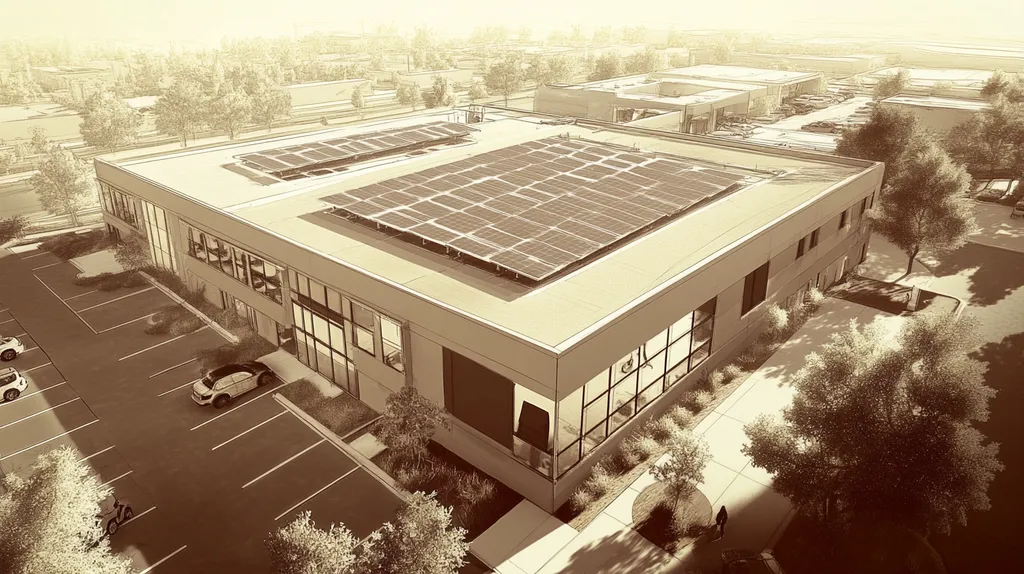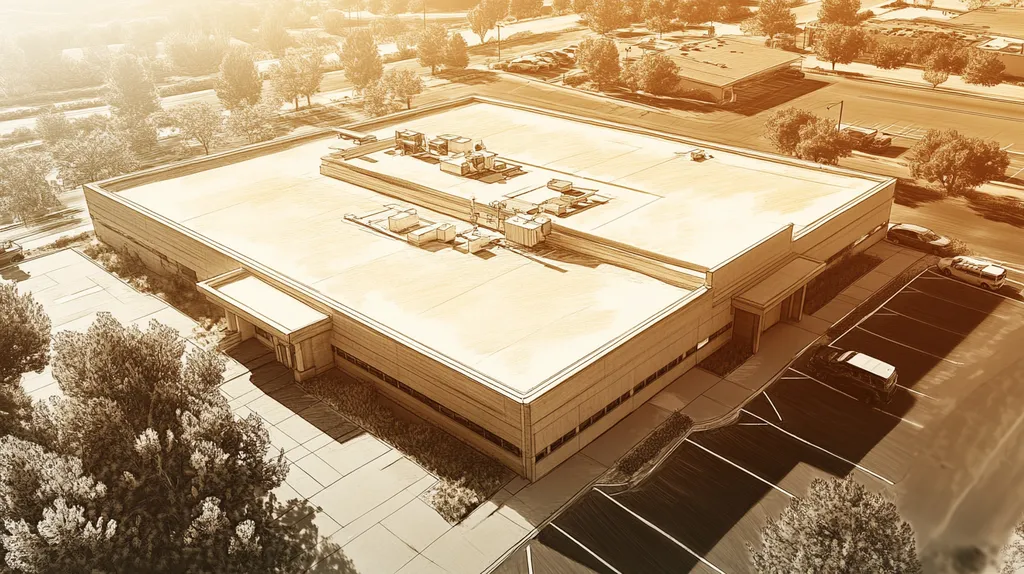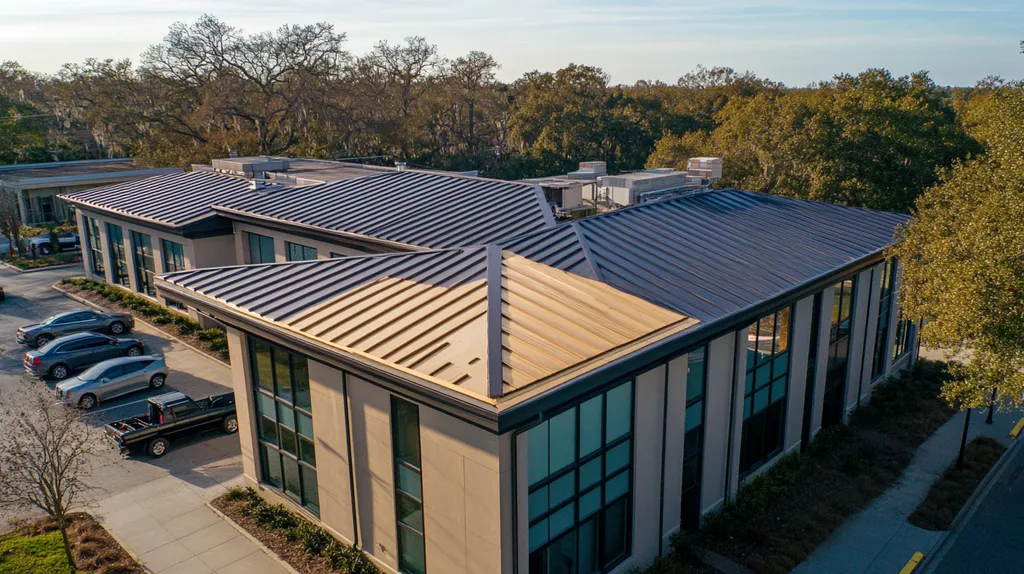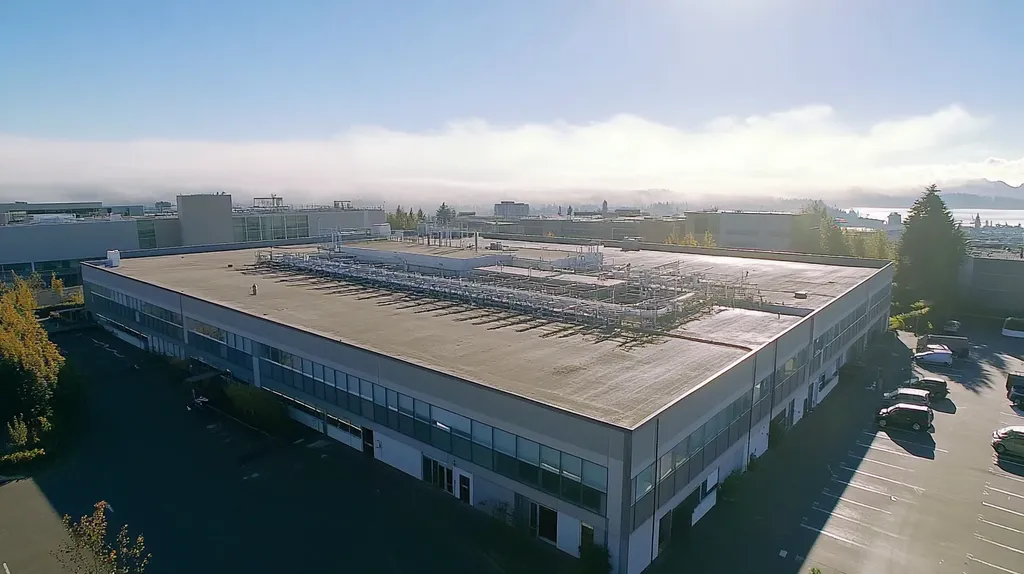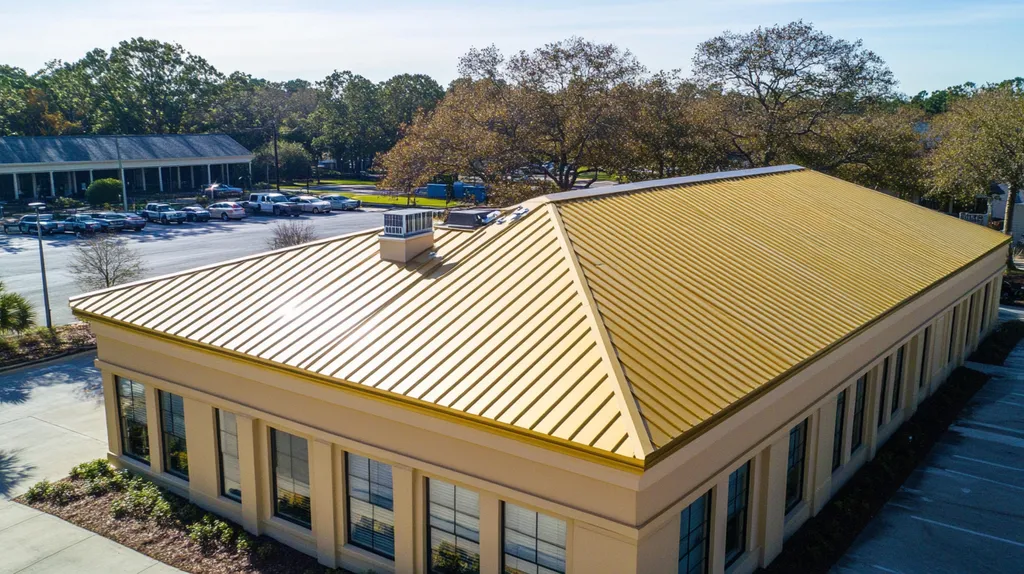Commercial roofing failures from weather damage cost U.S. businesses over $2.5 billion annually, with 40% of roofs failing before reaching half their expected lifespan due to inadequate weather resistance.
As extreme weather events increase in frequency and intensity, understanding the truth about weather resistance has become critical for protecting commercial building investments.
This analysis separates documented facts from common misconceptions about weather resistance, examining how material selection, installation quality, and maintenance practices determine a commercial roof’s ability to withstand environmental stresses.
SECTION 1: COMMON MISCONCEPTIONS
Commercial roofing misconceptions cost property owners millions annually in preventable damage and premature replacements. Industry data shows that 35% of commercial roofs fail before reaching half their expected lifespan due to misunderstandings about material selection and maintenance requirements. These failures stem from three critical areas of confusion: how long roofs should last, how weather truly affects roofing systems, and what different materials can actually deliver in real-world conditions.
Myths about Roof Lifespan
The most damaging myth in commercial roofing is that all roofing systems have similar lifespans. Metal roofing systems can last up to 70 years when properly maintained, while traditional asphalt options typically need replacement after 15-30 years. (source: Atto)
Local climate conditions dramatically affect how quickly roofing materials deteriorate. A roof in Arizona faces different challenges than one in Michigan, making standardized lifespan predictions unreliable.
Installation quality plays a crucial role in longevity. Even premium materials will underperform when installed incorrectly, leading to premature failure and unnecessary replacement costs.
Regular maintenance schedules significantly impact durability. Many owners mistakenly believe that newer roofs require minimal attention, when early-stage maintenance often prevents major issues later.
Misunderstandings of Weather Impact
Property owners frequently underestimate how daily weather patterns affect roofing performance. UV exposure, temperature fluctuations, and moisture levels all contribute to material degradation, even during seemingly mild conditions.
Extreme weather events receive attention, but cumulative damage from regular weather patterns often causes more significant long-term issues. Small amounts of standing water or minor wind damage can cascade into major structural problems.
Seasonal transitions pose particular risks to roofing systems. The freeze-thaw cycle in temperate climates can create microscopic damage that compounds over time, leading to unexpected failures.
Weather resistance requires a systematic approach to design and maintenance. Simple visual inspections miss many weather-related issues until significant damage has occurred.
Folklore Surrounding Materials
Marketing claims often oversimplify material performance, leading to unrealistic expectations. No single roofing material excels in all conditions or applications.
Cost comparisons frequently focus on initial expenses while ignoring lifetime value. Premium materials may cost more upfront but often deliver superior returns through reduced maintenance and longer service life.
Regional performance variations significantly impact material selection. Products that perform excellently in dry climates may fail prematurely in humid environments.
Material compatibility issues often get overlooked during renovations. Adding new materials to existing systems requires careful evaluation to prevent adverse interactions and premature failure.
SECTION 2: PRACTICAL IMPLICATIONS
Weather resistance failures in commercial roofing systems cost businesses billions annually in repairs, replacements, and business disruptions. When roofing systems fail to perform as expected, the consequences cascade throughout the building envelope, affecting structural integrity, energy efficiency, and operational continuity.
Understanding these practical implications is crucial for property owners and facility managers who must protect their investments while managing maintenance budgets effectively.
Structural Risks from Weather
Daily exposure to UV radiation, thermal cycling, and moisture infiltration creates cumulative stress on roofing systems. These ongoing environmental pressures can compromise structural integrity long before visible signs of damage appear.
Wind uplift forces present a particularly insidious threat, as they can gradually weaken attachment points and membrane seams. Even moderate wind events can exploit these weakened areas, leading to sudden and catastrophic failures.
Metal roofs offer superior protection against harsh weather conditions, including heavy rains, snow, hail, and high winds. While traditional asphalt roofs typically need replacement after 15-30 years, properly maintained metal roofing systems can protect buildings for up to 70 years. (source: Atto)
Ponding water compounds structural risks by adding excessive weight and accelerating material degradation. Just two inches of standing water can add nearly 10 pounds per square foot to the roof load, potentially exceeding design limitations.
Economic Impacts of Misinformation
Misunderstanding weather resistance capabilities leads to inappropriate material selections and inadequate maintenance budgets. These decisions often result in premature system failures and unplanned capital expenditures.
Emergency repairs typically cost 3-5 times more than planned maintenance or scheduled replacements. This cost multiplier severely impacts operational budgets and can force compromises in other critical facility maintenance areas.
Insurance premiums and deductibles frequently increase after weather-related claims, creating ongoing financial penalties. Many property owners fail to recognize how their roofing choices directly affect their total cost of ownership.
Warranty coverage gaps often emerge when weather resistance failures occur, leaving owners exposed to significant unexpected costs. Many standard warranties exclude damage from common weather conditions that properly selected and maintained systems should withstand.
Maintenance Strategy Failures
Most catastrophic roofing failures begin as minor maintenance issues that go unaddressed. Regular inspections and preventive maintenance could prevent up to 85% of premature roof failures.
Weather resistance deteriorates predictably over time, yet many maintenance programs fail to account for this degradation. This oversight leads to inadequate protection precisely when buildings need it most.
Seasonal maintenance requirements often get overlooked in standard maintenance protocols. Different weather patterns demand specific inspection and maintenance activities to maintain optimal performance.
Documentation gaps in maintenance records compromise warranty coverage and complicate insurance claims. Systematic record-keeping of weather-related inspections and repairs provides crucial protection for property owners.
SECTION 3: COST OF MISINFORMATION
Misinformation about commercial roofing weather resistance creates a costly ripple effect throughout building operations. Property owners who make decisions based on outdated beliefs or incomplete data face repair costs that can exceed $250,000 for premature roof replacement. The financial impact extends beyond immediate repair costs to affect insurance rates, energy efficiency, and building asset value.
Financial Consequences of Misbeliefs
The most damaging misconception involves equating initial cost savings with long-term value. Low-bid roofing solutions often result in systems that cannot withstand local weather conditions, leading to premature failure and expensive emergency repairs.
Weather resistance failures cascade through building systems, affecting insulation, HVAC efficiency, and structural integrity. These secondary damages often cost three to four times more than the original roofing issue would have cost to prevent.
Insurance carriers increasingly scrutinize roofing system choices when determining coverage rates and deductibles. Buildings with documented weather resistance deficiencies face higher premiums and reduced coverage limits.
Property resale value suffers when roofing systems show signs of weather-related deterioration. Potential buyers factor in immediate replacement costs, often reducing offers by double the actual repair costs.
Extended Repair Costs Over Time
Weather resistance deterioration follows a predictable acceleration curve when left unaddressed. Minor issues that could be resolved for hundreds of dollars often evolve into major structural problems costing tens of thousands.
Reactive maintenance approaches result in repair costs averaging 325% higher than preventive solutions. Emergency repairs during adverse weather conditions further inflate these costs due to labor premiums and material availability issues.
Business interruption costs frequently exceed direct repair expenses when weather resistance fails. Production delays, inventory damage, and temporary relocation expenses create substantial indirect financial impacts.
Documentation gaps regarding weather resistance maintenance often void warranty coverage, shifting the entire financial burden to property owners. These unexpected costs can devastate maintenance budgets and force deferral of other critical repairs.
Increased Maintenance Budgets
Traditional maintenance budgeting methods consistently underestimate weather resistance requirements. Properties operating with outdated maintenance assumptions typically exceed planned spending by 40% annually.
Deferred maintenance compounds at an average rate of 15% per year, creating an escalating financial burden. This acceleration means minor issues ignored today become major capital expenditures within 2-3 years.
Energy costs increase significantly when weather resistance deteriorates. Compromised roofing systems can reduce insulation effectiveness by up to 40%, leading to substantially higher heating and cooling expenses.
Staff resources often get diverted to managing recurring weather resistance issues, creating hidden labor costs. These diversions reduce efficiency in other maintenance areas, perpetuating a cycle of reactive spending.
SECTION 4: REALITY CHECK
Weather resistance testing reveals that 40% of commercial roofs fail prematurely due to material choices that don’t match local climate conditions. As extreme weather events increase in frequency and intensity, the gap between laboratory ratings and real-world performance continues to widen. Understanding the scientific principles behind weather resistance, actual material capabilities, and standardized testing results has become essential for protecting commercial building investments.
Scientific Facts on Weather Resistance
Weather resistance in commercial roofing involves complex interactions between UV radiation, thermal cycling, and moisture penetration. These factors work simultaneously to degrade roofing materials, with effects multiplying rather than simply adding together.
Solar reflectance and thermal emittance play crucial roles in material longevity. High-performance coatings can dramatically extend roof life by reducing peak surface temperatures and preventing premature aging.
Commercial roof coatings provide varying levels of protection depending on their formulation and application method. Different coating types offer specific advantages for UV resistance and water penetration prevention, with proper maintenance extending performance up to 20 years. (source: South Chicago Insulation)
Chemical degradation from environmental pollutants compounds weather-related stress. Urban environments typically accelerate material breakdown through increased acid rain exposure and industrial particle accumulation.
Actual Performance of Roofing Materials
Laboratory testing demonstrates significant variations in material performance under controlled conditions. However, real-world installation and maintenance quality often create larger performance gaps than material differences alone.
Single-ply membranes show superior resistance to UV degradation compared to traditional built-up roofing. Their molecular structure maintains flexibility longer, reducing crack formation and subsequent leaks.
Modified bitumen systems excel in thermal cycling resistance but require careful installation to achieve rated performance. Seam quality dramatically affects overall system integrity and weather resistance.
Metal roofing systems demonstrate the highest wind resistance when properly secured. Their interlocking panels create continuous protection that improves with proper maintenance rather than degrading over time.
Real-World Durability Tests
Standardized testing protocols measure specific performance attributes but often miss critical interaction effects. Field testing reveals that material combinations often perform differently than individual component ratings suggest.
Wind uplift resistance varies significantly between laboratory and installed conditions. Edge detail quality and attachment method consistency impact real-world performance more than material ratings alone.
Impact resistance testing shows that material thickness correlates less strongly with durability than internal reinforcement design. Modern composites often outperform traditional materials despite lower mass per square foot.
Accelerated aging tests provide useful comparisons but typically underestimate actual weathering effects. Real-world exposure often reveals failure modes that standardized testing misses entirely.
SECTION 5: EVIDENCE-BASED ALTERNATIVES
Commercial roofing failures cost businesses billions annually in repairs and lost productivity. Recent studies show that 40% of commercial roofs fail prematurely due to inadequate material selection and improper installation techniques. As extreme weather events intensify, property owners must adopt evidence-based approaches to protect their investments and ensure long-term performance.
Proven Durable Materials
Single-ply membranes like TPO and PVC demonstrate superior weather resistance through advanced polymer technology. These materials maintain flexibility across extreme temperature ranges while resisting UV degradation and chemical exposure.
Built-up roofing (BUR) and modified bitumen systems deliver exceptional durability through multi-layer protection, lasting up to 30 years when properly installed. These materials excel in thermal resistance and flexibility, making them ideal for demanding commercial applications. (source: LNS Home Improvements)
Metal roofing systems provide unmatched longevity, often exceeding 50 years with proper maintenance. Their interlocking panel design creates superior wind resistance while eliminating common failure points found in membrane systems.
Reinforced composite materials combine the benefits of multiple material types, offering enhanced puncture resistance and dimensional stability. These hybrid solutions particularly excel in environments with frequent thermal cycling.
Effective Weather Resistance Techniques
Proper drainage design prevents ponding water through strategic slope creation and drain placement. Even minimal standing water accelerates material degradation and increases structural loads beyond design limits.
Enhanced attachment methods significantly improve wind resistance through systematic fastener patterns and reinforced edge details. These techniques prevent progressive failure during high-wind events.
Thermal movement accommodation through proper expansion joints and detail work prevents material fatigue. Strategic placement of these components maintains system integrity despite daily and seasonal temperature fluctuations.
Vapor barrier integration protects insulation performance and prevents condensation damage. Proper placement and sealing of these layers maintains thermal efficiency while preventing moisture accumulation.
Long-term Cost Savings Strategies
Systematic maintenance programs detect and address minor issues before they escalate into major failures. Regular inspections focused on high-stress areas prevent emergency repairs and extend system lifespan.
Energy-efficient material selection reduces operational costs through decreased HVAC load. Reflective surfaces and proper insulation placement can reduce cooling expenses by up to 30% in warm climates.
Strategic phasing of roof replacement sections maximizes budget efficiency while maintaining protection. This approach allows properties to upgrade to superior materials without requiring complete system replacement.
Documentation of installation quality and maintenance history protects warranty coverage and supports insurance claims. Detailed records demonstrate proper care and justify material performance claims.
SECTION 6: TEST AND VERIFY
Inadequate testing and verification of roofing systems leads to premature failures that cost commercial property owners millions annually in repairs and replacements. Industry data reveals that over 40% of weather-related roofing failures could have been prevented through proper material testing and performance verification. Understanding and implementing comprehensive testing protocols has become essential as weather patterns grow increasingly extreme and unpredictable.
Laboratory Testing for Weather Resistance
Laboratory testing protocols measure specific performance characteristics under controlled conditions to predict real-world durability. Standard tests evaluate wind uplift resistance, impact strength, thermal cycling tolerance, and UV degradation rates.
Accelerated aging chambers expose materials to concentrated environmental stresses, compressing decades of wear into months of testing. These results help predict long-term performance and identify potential failure points before field installation.
Chemical resistance testing determines how materials react to acid rain, industrial pollutants, and biological growth. This information is crucial for properties in urban environments where atmospheric contamination accelerates degradation.
Standardized test methods ensure consistent evaluation across different manufacturers and material types. However, laboratory results must be interpreted within the context of actual installation conditions and local weather patterns.
Field Verification of Roof Performance
The National Roofing Contractors Association (NRCA) emphasizes combining laboratory data with systematic field inspections to verify roof integrity. Regular testing and verification schedules significantly reduce premature roof failures attributed to weather damage. (source: Atto)
Non-destructive testing methods like infrared thermography and electronic leak detection identify developing issues before visible damage occurs. These technologies allow precise mapping of moisture infiltration and insulation deterioration.
Core sampling provides direct evidence of material condition and system composition throughout the roof’s service life. Strategic sampling locations help track degradation rates and verify remaining service life.
Documentation of field performance creates valuable data for future material selection and maintenance planning. This information helps property owners optimize their roofing investments based on actual performance rather than theoretical predictions.
Independent Certification Standards
Third-party certification programs provide unbiased verification of material performance claims. Major certification bodies maintain rigorous testing protocols that exceed minimum building code requirements.
FM Global and Underwriters Laboratories (UL) ratings set industry benchmarks for weather resistance performance. These standards evaluate complete roofing systems rather than individual components in isolation.
Code compliance testing ensures materials meet local building requirements for wind resistance, fire safety, and structural loading. Certified materials typically demonstrate superior long-term performance compared to uncertified alternatives.
Certification maintenance requires ongoing quality control and periodic retesting. This continuous verification process helps manufacturers maintain consistent product performance while driving innovation in weather-resistant materials.
The Bottom Line
Weather-related commercial roof failures cost U.S. businesses over $2.5 billion annually, with 40% of systems failing before reaching half their expected lifespan due to inadequate testing and verification.
As extreme weather events intensify, the gap between laboratory ratings and real-world performance continues to widen, making evidence-based material selection and installation critical.
Property owners must shift from reactive maintenance to systematic verification protocols, including regular non-destructive testing and independent certification standards.
The data is clear: buildings utilizing proven materials, proper installation techniques, and regular testing protocols extend their roof lifespan by 20-30 years while reducing lifetime maintenance costs by up to 60%.
The future of commercial roofing depends on replacing industry myths with verifiable science and standardized testing procedures.
FREQUENTLY ASKED QUESTIONS
Q. What are common misconceptions about commercial roofs?
A. Many property owners mistakenly believe all commercial roofing systems have similar lifespans. In reality, different materials vary drastically in longevity, and local climate significantly influences durability. Increased exposure to UV light and temperature extremes can shorten the lifespan of various roofing materials. Regular maintenance is also crucial to ensure longevity.
Q. How does weather impact the lifespan of a commercial roof?
A. Daily and seasonal weather patterns can cause significant wear and tear on a commercial roof. Factors such as UV radiation, temperature fluctuations, and moisture levels contribute to degradation. Cumulative damage from prolonged exposure can lead to structural failures and reduced lifespan if not monitored carefully.
Q. What are the economic impacts of roofing misinformation?
A. Misunderstandings about roofing materials can result in poor choices leading to costly failures. Emergency repair costs can be three to five times higher than planned maintenance. Additionally, insurance premiums may increase for roofing systems that do not effectively resist weather-related issues, further straining budgets.
Q. How can property owners improve their roofing system’s weather resistance?
A. Effective weather resistance involves selecting durable materials and implementing rigorous maintenance plans. Using materials suited to local climates and ensuring proper installation can dramatically extend longevity. Regular inspections and timely repairs help identify minor issues before they escalate, maintaining system integrity.
Q. What testing methods verify a commercial roof’s performance?
A. Comprehensive testing includes laboratory assessments and field verifications. Laboratory tests measure resistance to UV degradation and thermal cycling, among other factors. Field inspections use techniques like infrared thermography to identify hidden issues. These combined methods ensure roofs meet performance standards and local conditions.
Q. What are cost-effective roof maintenance strategies?
A. Implementing a proactive maintenance schedule helps in identifying issues early. Regular inspections and targeted repairs can prevent costly emergency fixes later. Investing in energy-efficient materials also reduces operational costs, making long-term upkeep more manageable while preserving roof integrity.
Q. What is the importance of material selection in commercial roofing?
A. Selecting the right materials for specific environments is crucial in roofing success. Materials must match local weather conditions to provide adequate protection against elements. Inappropriate choices can lead to premature failures, high repair costs, and significantly reduced lifespan of the roof system.

